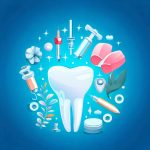The extensive repository of data accessible via Google can be somewhat overwhelming – the universe at our digital fingertips, making discerning trustworthy information a formidable task.
Although myriad individuals turn to ‘Dr. Google’ for their dental health queries – especially in the prevailing dental crisis – it remains imperative to verify the veracity of the knowledge one places faith in.
1, What constitutes the optimal home remedy for wisdom tooth discomfort?
Wisdom teeth that are either impacted or infected can usher in considerable distress, perturbing daily routines and activities. With a surge exceeding 5000% over the past week, this query evidently poses a pressing concern for UK patients grappling with the scarcity of dental appointments within the ongoing NHS dental predicament.
Over-the-counter analgesics or numbing gels can provide interim relief while awaiting consultation with a dental expert. Rinsing the oral cavity with warm saline water can combat inflammation effectively.
Employing an ice pack can further alleviate swelling. While the paramount solution for wisdom tooth anguish lies in seeking professional assessment, including X-ray examination to gauge tooth growth and administering antibiotics to counter infections, the aforementioned tips can serve as palliatives during the waiting period.
2, Does vaping adversely impact dental health?
It comes as no surprise that the quest for insights regarding vaping’s impact on teeth has escalated by over 80% of late, coinciding with the government’s novel incentive offering complimentary vaping products to those willing to bid adieu to cigarettes.
However, vaping does wield adverse effects on oral well-being – and they are not propitious. Exposing the gingival tissue to heated, desiccating vapor amplifies the risk of gum maladies and fetid breath; concurrently, flavored vapors escalate sugar accumulation within the oral cavity, potentially precipitating cavities.
Moreover, nicotine, a stimulant inherent in vaping, frequently triggers tooth grinding, culminating in enamel erosion and dental sensitivity. Restricting nicotine intake, adhering to meticulous oral hygiene, and maintaining optimal hydration are prudent measures to counteract vaping’s deleterious repercussions on oral health.
3, Can strawberries render teeth whiter?
Alas, the notion of utilizing strawberries for teeth whitening remains a chimera – as tantalizing as it might seem to indulge in these delectable treats while witnessing teeth lightening by a few shades, those contributing to the 170% surge in this query shall be disheartened to ascertain its implausibility.
If anything, blending strawberries with abrasive substances such as baking soda, as advocated across social media, can spell havoc for dental enamel due to their acidic nature.
4, Does excessive tooth brushing yield unfavorable outcomes?
‘Toothbrush abrasion’ occurs when teeth endure excessive, robust brushing, leading to receding gums and exposure of tooth roots, precipitating heightened dental sensitivity.
Given the 210% surge in related searches during the past week, it is evident that this inquiry confounds many. It remains imperative to meticulously brush teeth and gums twice daily – once in the morning and once in the evening. Aligner wearers, however, might need to do so more frequently to obviate food remnants and bacteria conducive to infections.
This practice should entail gentle pressure, allowing bristles to make contact without causing discomfort or abrasion, thereby forestalling gum and enamel erosion. Abiding by the regimen of twice-daily brushing, unless advised otherwise by a dental professional, and vigilantly observing indications such as bleeding gums or dental sensitivity, can aid in ascertaining an optimal brushing frequency and intensity.
5, Are transparent aligners superior to metal braces?
As dental technology advances, the query regarding the comparative merits of transparent aligners versus conventional metal braces has surged by 110% within the preceding three months alone. Determining the ‘superior’ modality hinges on the intricacy of required treatment.
Nevertheless, a host of benefits accompany transparent aligners, absent in fixed metal braces. Primarily, the discretion of imperceptible aligners empowers their continuous wear with confidence throughout the day; correspondingly, treatment durations generally prove shorter compared to traditional metal braces.
Furthermore, the ability to remove transparent aligners for eating, drinking, and engaging in sports confers a distinct advantage, alongside the convenience of maintenance.





